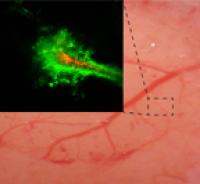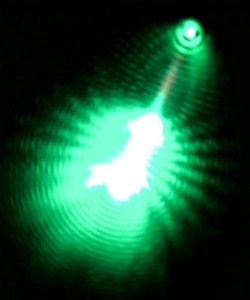Science
Hubble Spotted a Supernova in NGC 5806

Hubble sees a supernova explosion called SN 2004dg on the edge of NGC 5806, a spiral galaxy in the constellation Virgo. It lies around 80 million light years from Earth.
- Read more
- 440 reads
Improved nanoparticles deliver drugs into brain

Real-time imaging of a rodent brain shows that nanoparticles coated with polyethylene-glycol (PEG) (green) penetrate farther within the brain than particles without the PEG coating (red)
- Read more
- 457 reads
New Method for Synthesis of Noble Metal-Based Nanoparticles on Various Substrates

Particularly tested for carbon based substrates such as carbon nanocabon tubes, the proposed method has enabled the synthesis of platinum-cobalt nanoparticles featuring lower dimensions, narrower size distributions and higher stabilities compared to the conventional methods.
- Read more
- 414 reads
Kepler's Supernova Remnant: Was Kepler's Supernova Unusually Powerful?

In 1604, a new star appeared in the night sky that was much brighter than Jupiter and dimmed over several weeks. This event was witnessed by sky watchers including the famous astronomer Johannes Kepler. Centuries later, the debris from this exploded star is known as the Kepler supernova remnant.
- Read more
- 393 reads
NASA Observations Point to 'Dry Ice' Snowfall on Mars

Observations by NASA's Mars Reconnaissance Orbiter have detected carbon-dioxide snow clouds on Mars and evidence of carbon-dioxide snow falling to the surface.
- Read more
- 508 reads
Extreme Life Forms Might be Able to Survive on Eccentric Exoplanets

A hypothetical planet is depicted here moving through the habitable zone and then further out into a long, cold winter.
- Read more
- 489 reads
To Avoid Humans, Tigers Take Night Shift

A tiger’s eyes glow during the night on the same foot paths and roads humans use during the day to collect wood and grasses.
- Read more
- 393 reads
Sea Life Color Codes Food to Evade Danger

An example of bioluminescence: light emitted from a deep sea brittle star
- Read more
- 446 reads
NASA Mars Rover Curiosity's Arm Wields Camera Well

This view of the lower front and underbelly areas of NASA's Mars rover Curiosity combines nine images taken by the rover's Mars Hand Lens Imager (MAHLI) during the 34th Martian day, or sol, of Curiosity's work on Mars (Sept. 9, 2012).
- Read more
- 405 reads
Penn Researchers Make First All-optical Nanowire Switch

Laser light is emitted from the end of a cadmium sulfide nanowire.
- Read more
- 495 reads
Human Rights
Fostering a More Humane World: The 28th Eurasian Economic Summi

Conscience, Hope, and Action: Keys to Global Peace and Sustainability

Ringing FOWPAL’s Peace Bell for the World:Nobel Peace Prize Laureates’ Visions and Actions

Protecting the World’s Cultural Diversity for a Sustainable Future

Puppet Show I International Friendship Day 2020

